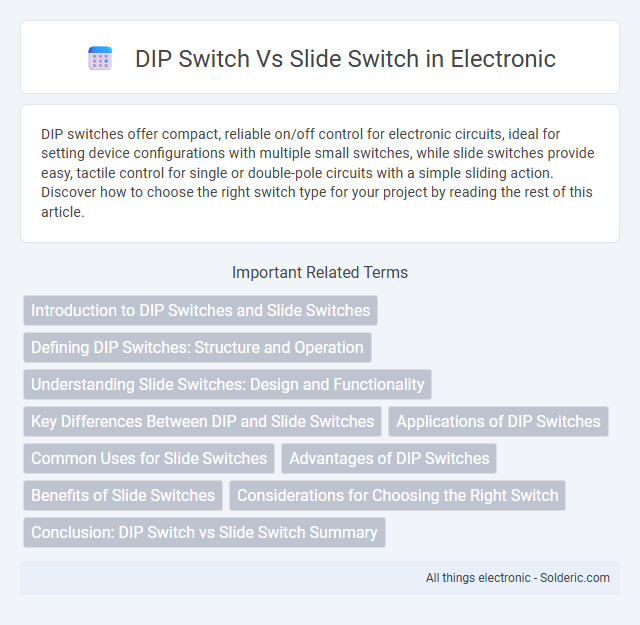DIP switches offer compact, reliable on/off control for electronic circuits, ideal for setting device configurations with multiple small switches, while slide switches provide easy, tactile control for single or double-pole circuits with a simple sliding action. Discover how to choose the right switch type for your project by reading the rest of this article.
Comparison Table
| Feature | DIP Switch | Slide Switch |
|---|---|---|
| Function | Multiple individual switch settings in one package | Single switch with sliding mechanism for ON/OFF or position control |
| Switch Type | Multi-pole, multi-throw | Single-pole, single-throw or single-pole, double-throw |
| Size | Compact with multiple switches in a small form factor | Typically larger than individual DIP switches, single unit |
| Usage | Configuring settings or input options on PCB | User on/off control in devices or circuits |
| Mounting | PCB through-hole or surface mount | PCB mount or panel mount |
| Actuation | Small slide or toggle for each switch | Single sliding lever moves the entire switch |
| Durability | Moderate, designed for configuration changes | Higher mechanical robustness for frequent switching |
| Common Applications | Address setting, feature enabling in electronics | Mode selection, power control in portable and consumer devices |
Introduction to DIP Switches and Slide Switches
DIP switches are compact, low-profile components designed for configuring electronic circuits by toggling individual switches on a single package, offering precise binary input control for devices and systems. Slide switches provide a user-friendly interface with a sliding actuator that changes electrical connections, ideal for simple on/off or mode selection applications in handheld devices or small electronics. Your choice between DIP and slide switches depends on space constraints, ease of operation, and the required number of switching options in your electronic design.
Defining DIP Switches: Structure and Operation
DIP switches consist of multiple small toggle switches arranged in a dual in-line package, allowing precise binary settings for electronic devices. Each switch within the DIP switch can be toggled between ON and OFF positions to control circuit configurations or device functions individually. Their compact structure makes DIP switches ideal for customizing hardware options without soldering or complex wiring.
Understanding Slide Switches: Design and Functionality
Slide switches feature a compact, linear sliding mechanism that shifts between open and closed electrical contacts, enabling simple on/off or multi-position control within circuits. Their design includes a lever or slider that physically moves to connect or disconnect contacts, offering reliable tactile feedback and ease of operation in compact electronic devices. Common applications range from consumer electronics to instrumentation, where precise, low-voltage switching is required.
Key Differences Between DIP and Slide Switches
DIP switches are designed for multi-position, small-scale circuit configuration with compact, toggle-like switches often used in electronics for setting hardware options, whereas slide switches offer a simple sliding mechanism for binary on/off control, favored for user-friendly manual operation in various devices. DIP switches typically support multiple individual switches in one package, allowing complex settings, while slide switches usually provide single or two-position switching with easier tactile feedback. The primary differences lie in their form factor, operation method, and application suitability, with DIP switches excelling in space-saving electronic configurations and slide switches preferred for straightforward mechanical user interface controls.
Applications of DIP Switches
DIP switches are widely used in electronics for configuring settings on circuit boards, such as setting device addresses, selecting modes, or enabling features without soldering. Common applications include computer motherboards, industrial equipment, and remote controls, where reliable, compact manual input is essential. You can easily customize hardware behavior during manufacturing or maintenance using DIP switches.
Common Uses for Slide Switches
Slide switches are commonly used in electronic devices for power control, mode selection, and adjusting operational settings due to their simple on/off or multi-position functionality. They are ideal for handheld gadgets, audio equipment, and small appliances where space constraints and ease of use are critical. Your project benefits from slide switches when requiring reliable, tactile input for quick toggling between device states.
Advantages of DIP Switches
DIP switches offer compact, reliable, and cost-effective solutions for manual configuration in electronic circuits, making them ideal for setting device parameters without the need for software control. Their multiple switch positions allow for easy customization and modification, providing enhanced flexibility in complex circuit designs. Unlike slide switches, DIP switches are less prone to accidental toggling, ensuring stable and consistent performance in various industrial and consumer applications.
Benefits of Slide Switches
Slide switches offer compact design and ease of use, making them ideal for applications requiring simple on/off control or multiple position settings. Their robust construction ensures reliable operation in environments with frequent switching, enhancing device longevity. You benefit from their straightforward installation and tactile feedback that improves user interaction in both consumer electronics and industrial equipment.
Considerations for Choosing the Right Switch
Selecting the right switch between a DIP switch and a slide switch depends on the application's complexity, with DIP switches offering multiple binary configurations suitable for circuit addressing or device settings. Slide switches provide simpler on/off functionality, ideal for user-friendly interface designs requiring manual control. Factors such as space constraints, electrical ratings, ease of use, and durability also influence the decision, ensuring optimal performance and reliability.
Conclusion: DIP Switch vs Slide Switch Summary
DIP switches offer compact, multi-position configurations ideal for circuit settings and device programming, providing reliable, stable positions for complex customization. Slide switches deliver easy, tactile on/off control with simple two or three-position layouts best suited for user-friendly interfaces and quick toggling. Choosing between DIP and slide switches depends on application requirements for precision versus accessibility in electronic device design.
DIP switch vs slide switch Infographic

 solderic.com
solderic.com